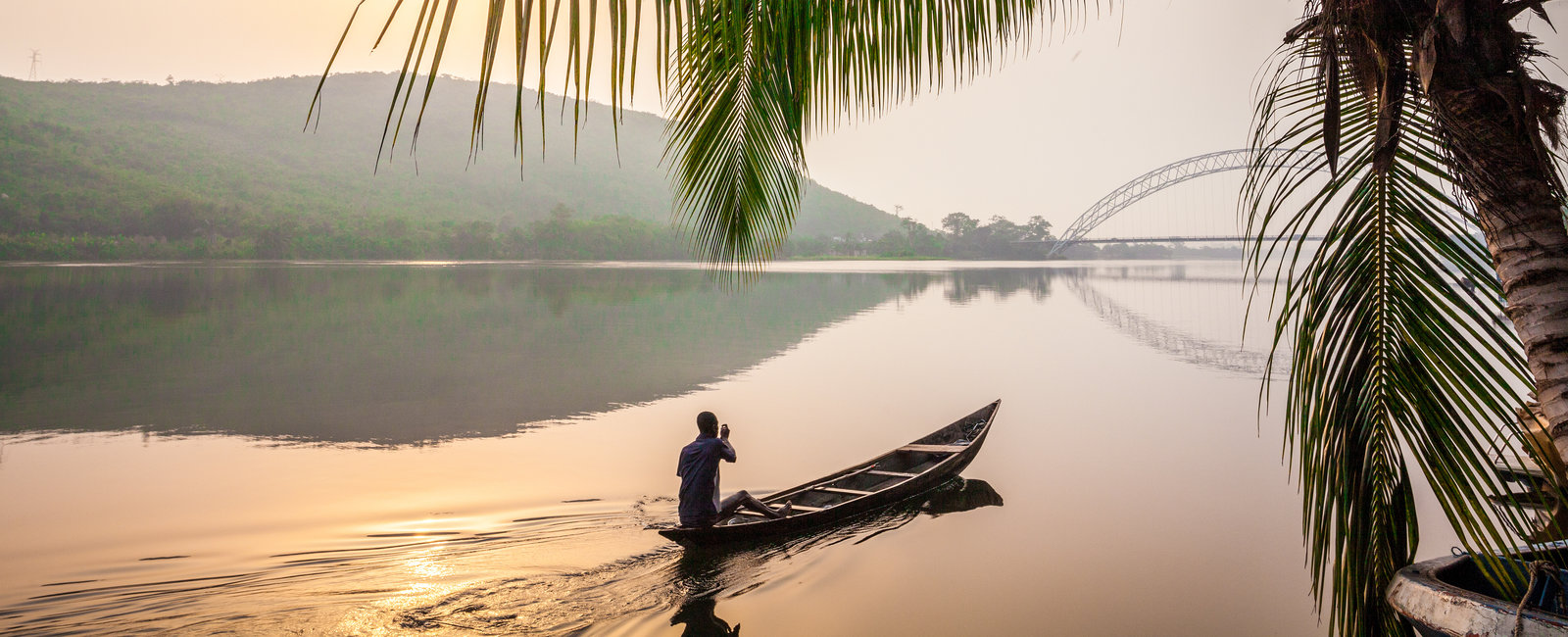Unlike our other elective destinations, most Ghana is open for business all year round. The main sights are largely unaffected by weather, and although there are seasonal rains, it is generally hot all year round. You may need to watch out for the dreaded humidity, but as long as you are prepared for a level of stickiness, you should be fine! Besides, there are plenty of waterfalls to cool off in and sleeping in a tree-top canopy brings a lovely breeze at night!
As a general guide, the rainy season in the South lasts from April to June and then again in September and October. Therefore, the best times to travel are November to March or July and August (also the most popular times for tourists). The rains are heavier and last longer in the central region. In the hotter and drier north, one rainy season lasts from April to October.
We shall start with the year-round attractions in this beautiful country. A big thanks to Ezekiel at the Ghana WTW house for his help compiling all the info!
All year...
The Coast - The stunning coastline stretches from the Ivory Coast to Togo. Along with beautiful, palm-lined beaches, there are also lots of historic forts that once served the slave trade. The Western region is famous for some of the best beaches in Ghana. Some of the most popular beaches apart from Axim Beach, which past and present housemates highly recommend, include Busua Pleasure Beach and Green Turtle Beach at Akwidaa, which are accessible throughout the year.
Cape Coast - Cape Coast was the British Colonial capital, and the faded grandeur of the buildings shows the wealth that was once there. Slave trading was significant here, and Cape Coast and Elmina castles played a big role. The Cape Coast castle has been extensively restored to host a moving museum.
Wechiau Community Hippo Sanctuary - Ride in a pirogue on the Black Volta River to observe hippos in their natural habitat - nothing between you and the hippo but a little stretch of water and the boatmen's good sense not to get too close. A truly unforgettable experience.
Kumasi Market - Largest in West Africa.
Kakum National Park - The 350m canopy walkway at the national park is the big draw here. It comprises seven viewing platforms that take you through the undisturbed virgin rainforest, linked by a circuit of narrow suspension bridges 30m above the forest floor. Many students stay overnight – sleeping on a tree platform under the stars! See Ghana’s indigenous plant life, rare butterflies, birds, and game (which could include the extraordinary bongo and forest elephant).
Tafi Atome Monkey Village - The sacred monkey sanctuary around Tafi Atome is easily accessible from Accra, the capital. It is a home of Mona monkeys and a fascinating place worth visiting all year round. It is open to tourists between the hours of 8:00 am and 5:00 pm daily.
Wli Falls - Wli waterfalls are the highest in Ghana and consist of the lower and upper falls. Reaching the falls is part of the adventure - with 11 log bridges spanning the river on your route to the falls. The pool at the bottom is perfect for a swim to cool down.
Boabeng-Fiema Sanctuary: The sanctuary is home to over 200 Geoffrey’s Pied Columbus and 500 Campbell's Mona Monkeys. The monkeys are protected and treated as sacred, so they have become used to being fed and looked after by village people who interact with them.
Adae Kese Festival - This is a very important, albeit rare, celebration of the Ashanti. It is held in an open space in the capital city of Kumasi. The festival is usually well attended and embraced by Ashanti from all walks of life.
January
Mole National Park - Mole is Ghana's largest national park and its biggest eco-tourism site. This park has 90 different mammal species, but perhaps the most famous are the elephants. January to March are the best times to visit.
Edina Bronya - This festival is a novel Christmas introduced to the people of Elmina during the Dutch era of the colonial period. The period coincides with the Dutch Festival, which falls on the first Thursday of January every year and is marked in Elmina to signify the bond of friendship between the Dutch and the people of Elmina.
Mt. Afadza is the highest mountain in Ghana, at an altitude of 885 meters (2,904 ft). It is highly recommended for those who love to hike, and it is open to visitors all year round but difficult to hike during the rainy season; thus, visitors are advised to follow the directions the guide gives.
February
Mole National Park—The 600 or so elephants are often drawn toward the two artificial watering holes near the lodges where most people stay. This is also one of the only places to go on a walking safari—many of our students have reported being yards away from elephants!
Mt. Afadza—At an altitude of 885 meters (2,904 ft), Afadzna is the highest mountain in Ghana. It is open to visitors all year round, but the wet season can lead to flooded and swampy areas on the approach.
March
Mole National Park—This is still a good month to visit Mole and spot some of the 90 different mammal species. In addition to the elephants, there are 80 leopards—a little harder to spot!
Paragliding Festivals (Kwahu Easter celebration)—The festival's history dates back to March 2003. In just a few short years, it has become an integral part of Ghana's annual Easter celebrations. The festival attracts Ghanaians and foreigners for more than three days of spectacular aerial fun, ceremony, and music.
April
Bobum or Dipo Festival - Dipo is celebrated in April by the people of Manya and Yilo Krobo in the towns of Krobo Odumase and Somanya, about 80 kilometres north of Accra. The mode of celebration is that adolescent girls are adorned with beautiful beads and half-clothed. The festival initiates such girls into womanhood.
Nzulezo Village-on-Stilts - Travelling out to Beyin, you can get a canoe to Nzulezo, a traditional village built entirely out of raffia. It stands on stilts over the river, and you can even spend the night. The best time to visit the settlement is during the rainy season (April to September) as you must reach it via dugout canoe.
May
Aboakye Festival - The festival is a celebration to mark the migration of these people from the ancient Western Sudan Empire, where they were led by two brothers and a god called Otu. The festival is celebrated in May and is a major event in Ghana.
Nzulezo Village-on-Stilts - Canoeing out to Nzulezo is an adventure, but spending some time on the manmade island will give you a fantastic insight into life for this unique Ghanaian group.
June
Nzulezo Village-on-Stilts - This is still a good time to travel to Beyin and take a dugout canoe to Nzulezo stilt village. It is a fantastic experience and a highlight for people who travel with Work the World.
July
Panafest, the Pan-African Historic Festival, is a major biennial cultural forum for Africans, people of African descent, and friends of the continent committed to the noble cause of Pan-Africanism. The venues are the historical towns of Cape Coast and Elmina. All participants must register.
Edina Bakatue Festival—Literally translated, it means "The opening of the Lagoon" or "The Draining of the Lagoon." It is celebrated to commemorate the Europeans' founding of the town of Elmina.
Nzulezo Village on Stilts—En route to Nzulezo, you often see monkeys swinging in the raffia trees, another highlight of the trip to the stilt village.
Boti Falls - A spectacular seasonal waterfall in the forest reserve at Huhunya. In the immediate vicinity are cascades; the twin fall dries up entirely in the dry season, mainly around November to April, but at its best between June and August.
“Asafotu Fiam” Festival - This annual festival commemorates the victory of warriors in battle, is celebrated by the Ga Adamgbe people, takes place between the last Thursdays of July, and ends in the first week of August.
August
The people of the Ga Traditional Area celebrate the “Homowo” Festival, which takes place in August. Homowo, which means hooting at hunger, is an annual month-long event.
“Agbamevoza” (kente festival) of the Agotime people - The chiefs and people of the Agotome traditional area, a few kilometres east of Ho, celebrate this annual Kente festival in August. This is a unique festival by all standards. The Agotime people claim they introduced the art of Kente weaving to present-day Ghana and consequently have marked this event with a colourful festival. A unique aspect of the festival is the Kente-weaving competition, and one that brings the best is crowned.
Nzulezo Village-on-Stilts—It sounds remote, but tourism is helping develop this unique village. Come armed with pens and sweets—the kids appreciate gifts.
Boti Falls - This is still a good time to visit Boti.
September
Fetu Afahye (Carnival) - The most attractive aspects of Ghanaian cultural life are the colourful traditional festivals and durbars frequently held throughout the country. This festival starts on the 1st of September every year.
Nzulezo Village-on-Stilts - The last month to easily visit Nzulezo. After this, the water levels are low, and reaching the village via boat is harder. It is possible (the locals manage to get into town to charge the batteries that provide them with power), but it's not that simple.
November
“Hogbetsotso Festival” - The festival is celebrated by Anlo Ewes, an ethnic group on the eastern coast of Ghana. An essential aspect of the festival worth witnessing is a durbar of Chiefs and the people, which takes place on the first Saturday of November in Anloga, a two-and-a-half-hour drive from Accra, the capital city.
Read more about our electives in Ghana.
Discover more about our Electives in Africa. You'll find various unique destinations offering eye-opening clinical experiences and adventures.

Start your journey
If you want to start your own Work the World adventure, get the ball rolling by choosing your area of study below.
If you want to start your own Work the World adventure, get the ball rolling by choosing your area of study below.






